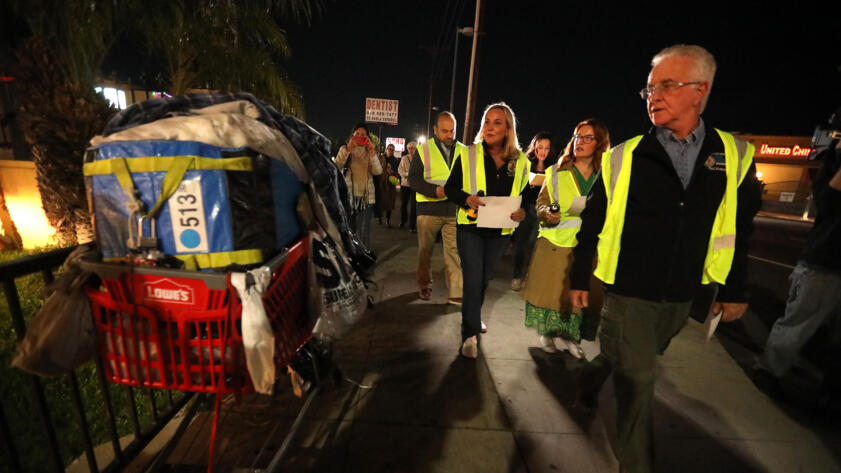Welcome to The Markup, where we use investigative reporting, data analysis, and software engineering to challenge technology to serve the public good. Sign up for Klaxon, a newsletter that delivers our stories and tools directly to your inbox.
One year after a Markup investigation revealed racial bias in Los Angeles’s housing intake system for people experiencing homelessness, local politicians have pressed for reforms and the agency responsible for housing is taking steps to make its approach more equitable and effective.

L.A.’s Scoring System for Subsidized Housing Gives Black and Latino People Experiencing Homelessness Lower Priority Scores
An investigation by The Markup found racial disparities in L.A.’s intake system for unhoused people
Shortly after our original investigation published, Los Angeles City Council Member Nithya Raman, who chairs the Housing and Homelessness committee, introduced a motion citing the article and calling on the Los Angeles Homeless Services Authority (LAHSA) to come up with a plan to reform its intake system. The legislation, approved unanimously, called specifically for greater fairness in the “vulnerability” scoring system that The Markup analyzed. Used by Los Angeles for the past decade, the system rated Black people as significantly less vulnerable than White people year after year, making them less likely to obtain subsidized permanent housing.
Black people are hugely overrepresented among unhoused people in L.A., making up about 9 percent of Los Angeles County’s population but about 30 percent of the county’s people experiencing homelessness.
“To see that the tool that we’re using to put people in line for housing was not actually housing unhoused Black Angelenos as quickly as we could was really surprising to me,” said Raman, who read the article in the Los Angeles Times, where it was co-published. Raman, who is currently running for re-election in District Four, in central LA, said the investigation “absolutely” spurred the council to act.
LAHSA, given a deadline of April 2023 in the legislation, still has not provided a reform plan. A spokesperson for the agency didn’t directly respond to a request for comment about the plan.
That the tool… to put people in line for housing was not actually housing unhoused Black Angelenos as quickly as we could was really surprising.
Nithya Raman, Los Angeles City Council
Raman said LAHSA has taken some steps in the past year to improve how it allocates housing. Among other changes, she said, the agency has started to prioritize some groups, including those already involved in housing programs and those who already have the documents required to move into a building, like an ID and social security number.
Meanwhile, the agency also de-emphasized the score’s importance in placing people for permanent housing. People applying for housing are scored on a 17-point scale. Previously, the people with the highest scores were given the highest priority, but now any person who scores an eight or above can be prioritized, depending on the other factors being considered.
Still, equity in the housing system remains a known problem. In November, researchers from the University of Southern California and the University of California Los Angeles, working in partnership with LAHSA, released a long-awaited study on racial bias in the system and ways to reform the scoring system, known as the VI-SPDAT.
The study, which analyzed scores across race and ethnicity, tracked with The Markup’s findings from earlier in the year, concluding that the scoring tool is biased toward White people and that it’s ineffective overall. The study, in some respects, went even further. Using data on who ultimately faced an “adverse” event, like jail or death, the researchers concluded that tool was “not much more accurate than a random guess at predicting vulnerability.”
The study suggested several ways the scoring system could become more accurate and equitable, some of which matched The Markup’s reporting. The scoring system asks intensely personal questions about a person’s life, including around issues like violence and substance abuse, and the report recommends rewording and reframing questions to make the survey less complex and more sensitive. A revised version of the system with new questions and scoring could substantially reduce bias, the researchers conclude.
For example, the study suggests that the existing question about whether anyone has “forced you or tricked you to do things that you do not want to do” should be amended to stress that answering yes “will not result in punishment or any negative consequences.” Another question currently asks, “Are there any medications like painkillers that you don’t take the way the doctor prescribed or where you sell the medication?” The study suggested softening it to, “Do you have medication that you choose to sell instead of taking to help support yourself financially? Answering yes to this question will not result in punishment or negative consequences for you.” Several questions were suggested for removal entirely.
Researchers concluded that tool was ‘not much more accurate than a random guess at predicting vulnerability.’
In a written statement, LAHSA spokesperson Christopher Yee acknowledged that it’s long been clear that “the VI-SPDAT has shortcomings related to equity,” adding that the survey is “long, cumbersome, and not trauma-informed in the content of the questions or administration process.”
Yee highlighted the study on recommended changes to the system and said the agency is “working with key partners and stakeholders to create a plan to implement and refine” a new iteration of the scoring system while it continues to use the old version.
The agency, he noted, has already dropped a requirement to score people for interim housing entry or time-limited subsidy programs, but will still require scoring for permanent housing. LAHSA must use some sort of prioritization system to access certain federal housing funds under rules established by the U.S. Department of Housing and Urban development.
The planned changes to the scoring system will first apply to screening for adults, and later the agency plans to explore changes to related tools for young people and families with children. The Markup found that racial disparities were even more stark for a variation of the VI-SPDAT used in Los Angeles for people under the age of 25.
Yee’s statement did not provide a timeline for the revised tool’s launch, but in a FAQ released alongside the study LAHSA said service providers could expect more information early this year on changes to the intake process, known as the Coordinated Entry System.
Raman, for her part, said she’s withholding judgment until data can show how those changes affect who is housed. But, she said, “there’s no question in my mind that CES needs reform.”





